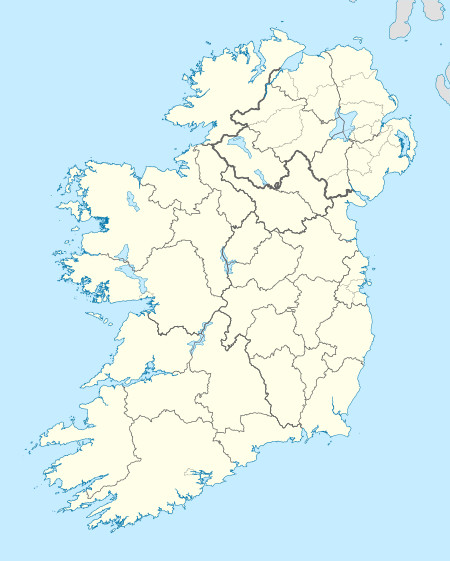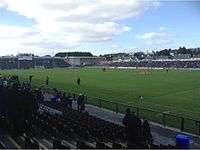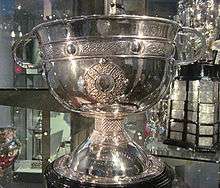All-Ireland Senior Football Championship
| All-Ireland Senior Football Championship | |
|---|---|
|
Current season or competition: | |
|
Logo | |
| Irish | Comórtas Shinsear Peile na hÉireann |
| Founded | 1887 |
| Region |
|
| Trophy | Sam Maguire Cup |
| No. of teams | 33 |
| Title holders |
|
| Most titles |
|
| TV partner(s) |
RTÉ, Sky Sports, BBC Northern Ireland, |
| Official website | http://www.gaa.ie |
The All-Ireland Senior Football Championship (SFC), the premier competition in Gaelic football, is an annual series of games played in Ireland and organised by the Gaelic Athletic Association (GAA). The All-Ireland Senior Football Championship Final is played on the third or fourth Sunday in September at Croke Park in Dublin, with the winning team receiving the Sam Maguire.
Contested by the top inter-county football teams in Ireland, the tournament has taken place every year since 1887—except in 1888, when the competition was not played due to a tour of the United States by would-be competitors.
History
The first Championship to be held featured club teams who represented their respective counties after their county championship. The 21 a-side final was between Commercials of Limerick and Young Irelands of Louth. The final was played in Beech Hill, Clonskeagh (not Bird Avenue) on 29 April 1888 with Commercials winning by 1–4 to 0–3. Unlike later All-Ireland competitions, there were no provincial championships, and the result was an open draw.
The second Championship was unfinished owing to the American Invasion Tour. The 1888 provincial championships had been completed (Tipperary, Kilkenny and Monaghan winning them; no Connacht teams entered) but after the Invasion tour returned, the All-Ireland semi-final and final were not played. English team London reached the final four times in the early years of the competition (1900–1903).
In 1892, inter-county teams were introduced to the All-Ireland Championship. Congress granted permission for the winning club to use players from other clubs in the county, thus the inter-county teams came into being. The rules of hurling and football were also altered: goals were made equal to five points, and teams were reduced from 21 to 17 a-side.
The 1903 Championship brought Kerry's first All-Ireland title. They went on to become the most successful football team in the history of the All-Ireland Senior Football Championship.[2]
The first half of the twentieth century brought the rise of several teams who won two or more All-Ireland titles in that period, such as Kildare, Mayo, Cavan, Wexford and Roscommon. In the 1990s, a significant sea change took place, as the All-Ireland was claimed by an Ulster team in four consecutive years (1991–1994). Since then Ulster has produced more All-Ireland winning teams than any other province.[3]
The All-Ireland Qualifiers were introduced in 2001. Later that year, the 2001 final brought victory for Galway who became the first football team to win an All-Ireland by springing through "the back door." In 2013, Hawk-Eye was introduced for Championship matches at Croke Park.[4] It was first used to confirm that Offaly substitute Peter Cunningham's attempted point had gone wide 10 minutes into the second half of a game against Kildare.[5] 2013 also brought the first Friday night game in the history of the Championship - a first round qualifier between Carlow and Laois.[6]
Teams
| Team | Colours | Most recent success | |
|---|---|---|---|
| All-Ireland | Provincial | ||
| Antrim | 1951 | ||
| Armagh | 2002 | 2008 | |
| Carlow | 1944 | ||
| Cavan | 1952 | 1997 | |
| Clare | 1992 | ||
| Cork | 2010 | 2012 | |
| Derry | 1993 | 1998 | |
| Donegal | 2012 | 2014 | |
| Down | 1994 | 1994 | |
| Dublin | 2016 | 2016 | |
| Fermanagh | |||
| Galway | 2001 | 2016 | |
| Kerry | 2014 | 2016 | |
| Kildare | 1928 | 2000 | |
| Laois | 2003 | ||
| Leitrim | 1994 | ||
| London | |||
| Limerick | 1896 | 1896 | |
| Longford | 1968 | ||
| Louth | 1957 | 1957 | |
| Mayo | 1951 | 2015 | |
| Meath | 1999 | 2010 | |
| Monaghan | 2015 | ||
| New York | |||
| Offaly | 1982 | 1997 | |
| Roscommon | 1944 | 2010 | |
| Sligo | 2007 | ||
| Tipperary | 1920 | 1935 | |
| Tyrone | 2008 | 2016 | |
| Waterford | 1898 | ||
| Westmeath | 2004 | ||
| Wexford | 1918 | 1945 | |
| Wicklow | |||
Format
Current format
The county is a geographical region in Ireland, and each of the thirty-two counties in Ireland organises its own GAA affairs through a County Board. The county teams play in their respective Provincial Championships in Connacht (which also includes teams from London and New York), Leinster, Munster, and Ulster. Kilkenny is currently unique among the 32 Irish county associations in not participating in the All-Ireland Senior Football Championship. The Provincial Championships operate through a knock-out cup competition format. They take place during the months of May, June and July. The winners of each of the four Provincial Championships earn a place in the All-Ireland Quarter-Finals, which take place in the month of August.
Each match is played as a single leg. If a match is drawn there is a replay. If that match ends in a draw a period of extra time is played, however, if both sides are still level at the end of extra time another replay will take place.
The twenty-nine teams that fail to win their respective Provincial Championships receive a second opportunity to reach the All-Ireland Series via the All Ireland Qualifiers (also known as the 'back door'). The qualifiers series takes place in the months of June and July and operates as follows:

- Qualifiers
- Round 1: All teams that fail to reach the semi-finals of their respective Provincial Championships (16 in total) compete in round one. An open draw system is used to divide the teams into eight individual match-ups. The winning eight teams progress to Round 2, while the losing eight teams are eliminated from the All Ireland Championship.
- Round 2: Each of the eight winning teams of Round 1 are drawn against the eight losing teams from the semi-finals of the four Provincial Championships. The winning eight teams progress to Round 3, while the losing eight teams are eliminated from the All Ireland Championship.
- Round 3: The eight winning teams from Round 2 are divided into four individual match-ups. An open draw is made to determine the four pairings. The winning four teams progress to Round 4, while the losing four teams are eliminated from the All Ireland Championship.
- Round 4: Each of the four winning teams of Round 3 are drawn against the four losing teams from the finals of the four Provincial Championships. The winning four teams proceed to the All-Ireland Series, joining the four Provincial Champions, while the losing four teams are eliminated from the All Ireland Championship.
- The All-Ireland Championship
- All-Ireland Quarter Finals: The four Provincial Champions are drawn against the winning four teams from Round 4 of the All-Ireland Qualifiers. The four winning teams qualify for the All-Ireland Semi-Finals.
- All-Ireland Semi Finals: The winning four teams from the All-Ireland Quarter Finals play-off. The two winning teams qualify for the All-Ireland Final.
- All-Ireland Final: The two remaining teams meet in the All-Ireland Final, usually on the third Sunday in September. The winning team is crowned All-Ireland Champions.[7]
Proposed new format for 2018
The Ard Stiúrthoir of the GAA has proposed that the eight teams who currently contest the four knock-out quarter-finals should compete in two groups of four teams. The group winners and runners-up would progress to the two knock-out semi-finals.[8]
Historic format
For the first All-Ireland championship in 1887, the competition was played on an open draw knockout basis. From 1888, the provincial system was introduced, whereby the counties in each of Ireland's four provinces would play each other on a knockout basis to find provincial champions. These four champions would meet in the All-Ireland semi-finals. The structure outlined above was adopted in 2001 to allow more games to be played, but still retain provincial championships and the knockout structure, resulting in every game continuing to be a meaningful fixture, with no dead-rubber league format matches being played out.
All-Ireland winners and finalists

Over the four Sundays of September, All-Ireland Finals in men's football, ladies' football, hurling and camogie take place at Croke Park, the national stadium of the GAA. Two grades are played on each final day, the senior team and the minor team (consisting of younger players, under the age of 18, who have participated in that year's All-Ireland Minor Football Championship). Guests who attend these events include the President of Ireland, the Taoiseach and other important dignitaries. The football final is considered the pinnacle event of this period.
The final game of the All-Ireland Senior Football Championship takes place on the third Sunday of September. The men's decider regularly attracts crowds of over 80,000. The winning team captain receives the Sam Maguire Cup. The current champions are Dublin.
Venues
Records and statistics
Although Wexford were the first county to win four consecutive All-Ireland Senior Football Finals (1915–18), historically Kerry have been the most successful football team in the All-Ireland Senior Football Championship. As of 2015, Kerry have won the competition on 37 occasions, winning in four consecutive years twice (1929–1932 and 1978–1981) and for three consecutive years twice as well (1939–1941 and 1984–1986). Galway were the first team from the western province of Connacht to win an All-Ireland title, doing so in 1925. The 1933 final brought victory for Cavan, who became the first team from the northern province of Ulster to win an All-Ireland title.
Two teams have won the All-Ireland Senior Football Championship as part of a double with that year's All-Ireland Senior Hurling Championship, namely Cork (1890 and 1990) and Tipperary (1895 and 1900). The championship has never been won by a team from outside Ireland, though London have played in five finals.
Dublin are the reigning champions, having defeated Mayo in the 2016 All-Ireland Senior Football Championship Final.
See also
- All-Ireland Senior Hurling Championship
- All-Ireland Senior Club Football Championship
- Leinster Senior Football Championship
- Ulster Senior Football Championship
- Connacht Senior Football Championship
- Munster Senior Football Championship
- List of Gaelic games competitions
Notes
References
- ↑ "From Sam Maguire to Dr Maguire – St Eunan's and Naomh Conaill do battle in County Final". Donegal Daily. 4 November 2012. Retrieved 4 November 2012.
A huge crowd is expected at MacCumhaill Park at a time when gaelic games in the county have never had a higher profile. Nothing beats being there, as the GAA slogan goes, but for the neutrals who can't be in Ballybofey, the game is live on TG4 from throw-in at 4pm.
- ↑ "GAA Roll of Honour".
- ↑ Moran, Seán (26 May 2013). "Donegal hoping to avoid being fifth All-Ireland champions in 20 years to fall at first hurdle in Ulster: Uneasy lies the head that wears the northern crown". The Irish Times. Irish Times Trust. Retrieved 26 May 2013.
- ↑ "GAA hopes Hawk-Eye will eliminate contentious points". RTÉ Sport. 15 May 2013. Retrieved 15 May 2013.
- ↑ "Hawkeye makes successful debut". Hogan Stand. 2 June 2013. Retrieved 2 June 2013.
- ↑ "Qualifiers include first ever Friday night game". RTÉ Sport. 17 June 2013. Retrieved 17 June 2013.
Carlow will play Laois on 28 June in Dr Cullen Park, the first time a Championship game will take place on a Friday night.
- ↑ GAA
- ↑ "GAA propose to scrap All-Ireland SFC quarter-finals and introduce group stage". www.hoganstand.com. Hogan Stand. Retrieved 14 August 2016.






